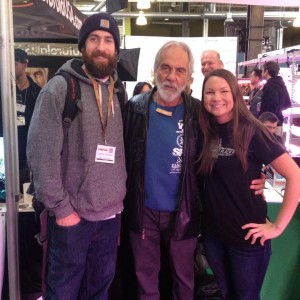Chelsea Parkhurst: A woman’s perspective on CannaCon
Unfortunately I wasn’t able to get up to CannaCon in Seattle this past weekend. (We don’t have much of a travel budget here).
But the folks at High End Market Place and many other Clark County businesses were able to go and were out in force.

Nice to see Southwest Washington represented up there! With so much focus on Seattle, I think sometimes people forget that Clark County is one of the state’s biggest markets (thanks, to a large extent, because of our proximity to Portland).
Chelsea Parkhurst from HEMP was nice enough to share a review of her experience at CannaCon with Cannabis Chronicles.
Sounds like there were some great informational seminars. But beyond that she mentioned something that also bothers me – the use of women as sex objects in cannabis industry marketing.
A few months back, I started looking for cannabis publications aimed at women. I had hopes when I saw something from High Times Magazine called Miss High Times, until I clicked through to have a look. Turns out it’s basically a beauty contest to find “the country’s cutest, coolest stoner chicks.”
Have a look around at any number of the more established cannabis magazines and you’ll see something very similar – scantily clad women used to sell products.
After some searching, though, I was able to find two publications that actually are aimed at women. Ladybud is a great well-rounded site for women interested in cannabis. And the Marijuana Business Association has also been forward-thinking with its group the MJBA Women’s Alliance.
I also find that in general, business focused publications, such as Marijuana Venture Magazine, don’t objectify women in the way that stoner culture magazines tend to. Neither does CannaCon itself, for that matter. The phenomenon isn’t the convention’s fault.
And of course, this isn’t just limited to the cannabis industry – have a look at some of the big corporate beer ads on TV and you’ll see something similar.
But with a history in cannabis culture of being open minded and supportive of new ideas, I think it’s time to put some of the boys club history behind us and move forward.
After all, do companies really want to alienate half of their customer base?
Check out Chelsea’s guest column below!
Cheers,
-SueVo (sue.vorenberg@columbian.com)
A woman’s perspective on CannaCon
By Chelsea Parkhurst
Production & Design at High End Market Place
This week I attended CannaCon in Seattle, ready to shake hands and explore the latest and greatest in the cannabis industry.
Upon arrival, the computer system crashed, causing a longer wait for registration. To most, this was not a big deal, but some were more impatient than others.
We had to watch as an ill-tempered man exchanged words of profanity with an apologetic staff member. I hoped that this misguided display wasn’t some sort of premonition of the things come.
Once we entered the convention, things started to look up.
Industrial Hemp Farming Part 2 with Joy Beckerman was the first seminar that we attended. Beckerman was extremely knowledgeable about the entire process of HEMP cultivation. She was also aware of the laws and regulations that have shaped the industry thus far, though there is still plenty of work to be done.
After her seminar I felt inspired and excited that there are other women enthusiastic about educating the public.
Although I had some great conversations throughout the convention, I noticed something was off.
As I looked down the line of companies, my eyes were drawn towards the marketing materials provided.
With the majority of vendors being male, it was disconcerting to see the sexualization of woman used as a primary marketing technique. There were ladies dressed in nurse costumes ready to ease your pain with their medical marijuana. There was a black and white image of a woman with bedroom eyes parting her red lips with one finger in preparation for a phallic blunt. And of course, the classic truck flap gal leaning back with a skinny body and large breasts seemed to be the preferred image of many brands.
Unfortunately, when I expressed uncertainty towards all of this, I was simply told to relax and that “sex sells.”
Thankfully, Jeff Raber from The Werc Shop was able to take my mind off of all that with some interesting science. He gave an in-depth explanation of the molecular breakdown of marijuana in all of its different forms and the need for a better system of strain classification and standardization.
I am excited about where the cannabis industry is headed, and would like to see a lot less of sexual commodification just to fulfill the male gaze, which can amount to a fairly degrading experience for female consumers.
Retailers have the option to carry whatever brands they want. If they collectively choose to steer away from sexist marketing, the producers will not have the economic justification for continuing to push it.
Instead, we can consider more important things, like the product itself. In turn, this can empower graphic designers and artists to utilize creativity beyond using generic exploitative imagery as advertising.
The CannaCon convention was ultimately a positive experience with several kinks, pun intended, to be ironed out.
We are all learning together within this industry and should focus on knowledge that’s sexy, if indeed it is sex that sells. Change starts at a local level, and we are in a unique position to profoundly impact the future of the cannabis and HEMP industry from the ground up, literally.


